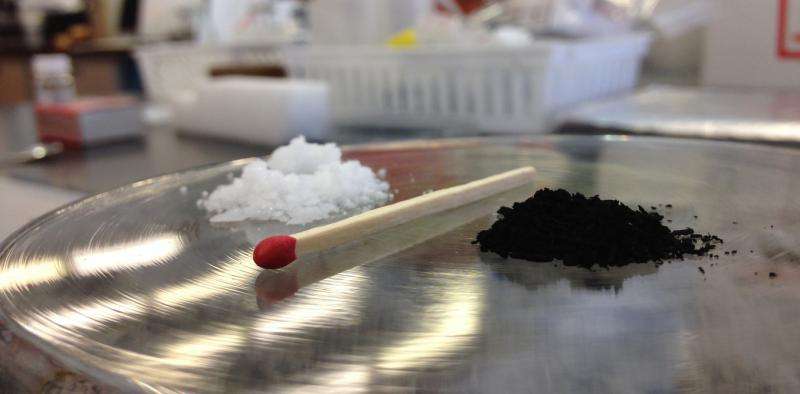All you need for quantum computing at room temperature is some mothballs

Much of the current research on the development of a quantum computer involves work at very low temperatures. The challenge to make them more practical for everyday use is to make them work at room temperature.
The breakthrough here came from the use of some everyday materials, with details published today in Nature Communications.
A typical modern-day computer represents information using a binary number system of discrete bits, represented as either 0 and 1.
A quantum computer uses a sequence of quantum bits, or qubits. They can represent information as 0 or 1 or any of a series of states between 0 and 1, known as quantum superposition of those qubits.
It's this leap that makes quantum computers capable of solving problems much more quickly and powerfully than today's typical computers.
All in the spin
An electron has a charge and a spin – the spin determines if an atom will generate a magnetic field. The spin can also be used as a qubit as it can undergo transitions between the spin-up and spin-down quantum states, represented classically by 0 and 1.
But the electron spin states therefore need to be robust against "decoherence". This is the disordering of the electron spins during quantum superposition which results in the loss of information.
The electron spin lifetimes are affected by lattice vibrations in a material and neighbouring magnetic interactions. Long electron spin lifetimes exceeding 100 nanoseconds are needed for quantum computing.
Cooling a material to low temperatures close to absolute zero, -273C, does increases the spin lifetime. So too does the use of magnetically pure conducting materials.
Cool computing
So quantum devices using atomically heavy materials such as silicon or metals need to be cooled to low temperatures near absolute zero.
Other materials have been used to perform quantum manipulations at room temperature. But these materials need to be isotopically engineered, which requires large facilities like nuclear reactors, and pose limitations around qubit density.
Molecules such as metal-organic cluster compounds have also been used, but they too require low temperatures and isotopic engineering.
There are clear and established trade-offs to be considered regarding the feasibility of applying a qubit material system for quantum computing.
A conducting material of light atomic weight with a long electron spin lifetime exceeding 100 nanoseconds at room temperature would permit practical quantum computing. Such a material would combine the best aspects of current solid-state material qubit schemes.
Why you need mothballs
We have demonstrated that a long conduction electron spin lifetime in metallic-like material made up of carbon nanospheres can be achieved at room temperature.
This material was produced simply by burning naphthalene, the active ingredient in mothballs.
The material is produced as a solid powder and handled in air. It can then be dispersed in ethanol and water solvents, or deposited directly onto a surface like glass. As the material was remarkably homogeneous, the measurements could be made on the bulk solid powder.
This allowed us to achieve a new record electron spin lifetime of 175 nanoseconds at room temperature. This might not sound like a long time, but it exceeds the prerequisite for applications in quantum computing and is about 100 times longer than that found in graphene.
This was possibly due to the materials' self-doping of conduction electrons and their nanometre spatial confinement. This basically means the spheres could be made entirely from carbon while preserving their unique electronic property.
Our work now opens the possibility for spin qubits to be manipulated in a conducting material at room temperature. This method doesn't need any isotopic engineering of a host material, dilution of the spin-carrying molecule, or cryogenic temperatures.
It allows a higher density packing of qubits to be, in principle, achieved over other promising qubits like those used in silicon.
Reduced costs
This very easy preparation of a carbon material using common laboratory reagents reduces many of the technological barriers to realising practical quantum computing.
For example, the refrigeration systems required to cool materials close to absolute zero can cost upwards of millions of dollars and occupy physical spaces the size of large rooms.
To build a quantum computer one would need to demonstrate that qubits can undergo manipulations involving the superposition of quantum states and also to a build a functioning quantum logic gate (switch).
In our work we have demonstrated the former while making the latter a question of engineering rather than breakthrough science. The next step would be to build a quantum logic gate – an actual device.
What is exciting is that the material is prepared in a form suitable for device processing. We have already demonstrated that the individual conducting carbon nanospheres can be isolated on a silicon surface.
In principal, this may provide an initial avenue to high-density qubit arrays of nanospheres that are integrated onto existing silicon technologies or thin-film-based electronics.
More information: Bálint Náfrádi et al. Room temperature manipulation of long lifetime spins in metallic-like carbon nanospheres, Nature Communications (2016). DOI: 10.1038/ncomms12232
Journal information: Nature Communications
Source: The Conversation
This article was originally published on The Conversation. Read the original article.
![]()



















